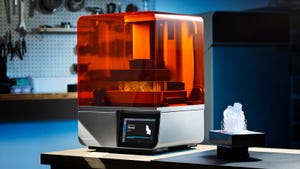A polyamide 6 compound blended with carbon powder is able to reliably dissipate static electricity, protecting the radon gas detection element at the heart of an at-home radon detection kit. Electrafil NY-7/EC is used for the molded housing of RSSI’s (www.rssi.us) Alpha-track Radon Detector, a $25 kit that allows homeowners to check for the carcinogenic, invisible, odorless, and tasteless gas.
January 7, 2009
A polyamide 6 compound blended with carbon powder is able to reliably dissipate static electricity, protecting the radon gas detection element at the heart of an at-home radon detection kit. Electrafil NY-7/EC is used for the molded housing of RSSI’s (www.rssi.us) Alpha-track Radon Detector, a $25 kit that allows homeowners to check for the carcinogenic, invisible, odorless, and tasteless gas. Tom Drye, director of sales and marketing for Electrafil’s manufacturer, Techmer Lehvoss Compounds (Clinton, TN), says that the compound is rated electrically conductive, 10E2 to 10E6 Ohm-cm, according to the ASTM D257 standard.
Techmer PM's Electrafil compound Techmer PM’s Electrafil compounds could find a home in a wide range of applications. |
This housing has slotted vents that allow airborne radon gas particles to enter, and if the housing didn't dissipate static electricity, radon particles traveling through the vents could pick up a static charge from the plastic housing, resulting in testing errors, with static charges negatively affecting dispersion of particles onto the detection media. Charged radon particles can attract each other, clumping together onto the detector foil, leading to inaccurate readings when RSSI’s laboratory analyzes the detector element. The company says the Electrafil NY-7/EC polyamide has eliminated all problems associated with static, for more accurate tests.
Drye says there are a variety of potential applications for Electrafil compounds, including automotive fuel-delivery components, printer parts, conductive monofilament, and more. Electrafil denotes the company’s conductive grades with compounds using a variety of base resins, including, but not limited to PP, ABS, PC, PA, POM, PEI, PEEK, and PBT. The compounds can also feature different fillers, including stainless steel for electromagnetic interference shielding; carbon fibers for conductivity and strength; carbon powder, as applied by RSSI; and conductive alloys for static dissipation and custom colors.
Techmer PM, Clinton, TN, U.S.A. +1 865-457-6700; www.techmerpm.com
You May Also Like



